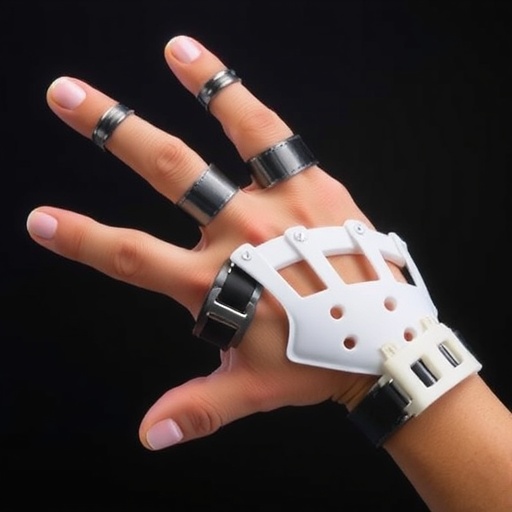In a groundbreaking advancement poised to transform the rehabilitation landscape for arthritis and other hand mobility challenges, researchers at Carnegie Mellon University’s Interactive Structures Lab have unveiled a pioneering finger brace that dynamically toggles between stiffness and flexibility. This innovative device addresses a critical limitation in conventional orthopedic supports: the inability for patients to maintain continuous support while simultaneously enabling necessary finger movement during therapy, a balance that has long frustrated both patients and clinicians alike.
The inspiration behind this novel orthotic emerged from the personal experience of Yuyu Lin, a Ph.D. student at Carnegie Mellon’s Human-Computer Interaction Institute (HCII). Observing a close friend’s struggle with arthritis, Lin recognized the cumbersome trade-off her friend faced between wearing restrictive braces and performing everyday tasks like typing. Traditional braces provide immobilization essential for healing but impede natural motion, forcing patients to remove their devices during exercises, often resulting in irregular use and delayed recovery.
Collaborating with her colleagues in the Interactive Structures Lab, Lin spearheaded the development of a fully customizable brace capable of transitioning seamlessly between rigid and flexible states with a simple finger push or flex. This capability eliminates the need for brace removal, ensuring that patients can maintain therapeutic immobilization while benefiting from timely mobilization exercises essential for healthy joint recovery and pain management.
The engineering behind this brace relies on a bistable mechanism composed of two rigid segments connected by an elastic band. This band functions as a dynamic latch system: when the user flexes the finger to a defined threshold, the band releases, enabling finger articulation; when extended, the band automatically re-engages, restoring essential rigidity. Analogous to the familiar snap bracelet’s bistability, this design cleverly harnesses mechanical hysteresis to switch the orthosis state in response to natural finger movements without additional tools or complex adjustments.
Clinically, the brace targets the proximal interphalangeal joint—the second knuckle—an area notoriously prone to stiffness and difficult to treat due to challenges in balancing immobilization with controlled early mobilization. Traditional static orthoses often immobilize this joint continuously, hindering rehabilitation exercises and sometimes leading to permanent functional limitations. This new smart brace, integrating insights from biomedical professionals and musculoskeletal biomechanics, offers adaptive support fine-tuned to this critical anatomical region.
A central advancement lies in the brace’s customization framework. Patients input three key biometric parameters into a cutting-edge computational design tool: precise finger dimensions, measured using simple instruments like rulers; flexion strength, quantified with force gauges; and extension angles, determined via protractors. Leveraging these data points, the software simulates optimal brace configurations, calculating necessary torque thresholds to ensure safe yet effective switching between the brace’s states. This digital tailoring guarantees personalized fit and function, an important step beyond one-size-fits-all supports.
Significantly, the entire device is designed for additive manufacturing through 3D printing, emphasizing accessibility and ease of production. By distributing customizable digital files, patients or clinicians can fabricate these braces locally, bypassing long wait times and costly fabrication processes. Moreover, the brace’s assembly-free nature—born from an integrated design ethos—eliminates the need for hardware installation, minimizing user frustration and maximizing adherence.
This innovation reflects a multidisciplinary collaboration involving expertise from human-computer interaction, mechanical engineering, biomechanics, design, and clinical medicine. The team includes students and faculty from Carnegie Mellon University, as well as partners from Stanford University and the University of Pittsburgh Medical Center who contributed clinical insights validating the orthosis’s therapeutic value and usability.
Looking forward, Lin envisions extending this paradigm to develop a broader class of adaptive wearable devices targeted at users with limited mobility. These devices will prioritize comfort, ease of use, and simplicity, addressing unmet needs for dynamic assistive technologies that integrate smoothly into daily life. The potential exists to improve quality of life and rehabilitation outcomes for diverse populations facing functional impairments.
Financial support from the National Science Foundation and Carnegie Mellon’s Center for Machine Learning and Health underscores the project’s significance and innovative nature. The research will be formally presented at the Association for Computing Machinery’s Symposium on User Interface Software and Technology (UIST ’25), highlighting the intersection of user-centered design, computational modeling, and biomedical engineering.
In a healthcare context increasingly embracing personalized and adaptive solutions, the realization of a 3D-printed, bistable finger orthosis represents a significant stride toward intelligent rehabilitation aids. It exemplifies how leveraging computational design alongside emerging materials and fabrication methods can directly address persistent clinical challenges, fostering better therapeutic adherence, faster recovery, and ultimately enhanced patient autonomy.
With further clinical validation and refinement, this new class of smart orthoses could revolutionize the management of chronic conditions like arthritis, overuse injuries, and post-surgical recovery by removing cumbersome barriers and allowing patients to move more naturally while receiving support. The paradigm shift from static immobilization to dynamic support marks a transformative leap in orthotic innovation.
Subject of Research: Fully customizable, bistable finger brace designed for efficient rehabilitation management and mobility support in arthritis and related conditions.
Article Title: Dynamic Finger Brace Innovation: Bridging Rigidity and Flexibility Through 3D Printed Bistable Orthoses
News Publication Date: Not explicitly provided; research to be presented in 2025.
Web References:
Interactive Structures Lab: https://interactive-structures.org/publications/2025-09-bistable-orthosis/?utm_source=chatgpt.com
ACM Symposium on User Interface Software and Technology (UIST ’25): https://uist.acm.org/2025/
Carnegie Mellon Human-Computer Interaction Institute: https://hcii.cmu.edu/
Image Credits: Carnegie Mellon University
Keywords: Metamaterials, Health and Medicine, Assistive Technology, Rehabilitation, Bistable Mechanisms, 3D Printing, Orthoses, Human-Computer Interaction, Biomechanics
Tags: arthritis treatment advancementsCarnegie Mellon University researchcustomizable finger bracedynamic finger supportflexible orthotic deviceshand mobility challengesinjury recovery solutionsinteractive orthopedic solutionsorthopedic innovationspatient-centered rehabilitationrehabilitation technology for arthritiswearable therapy devices






